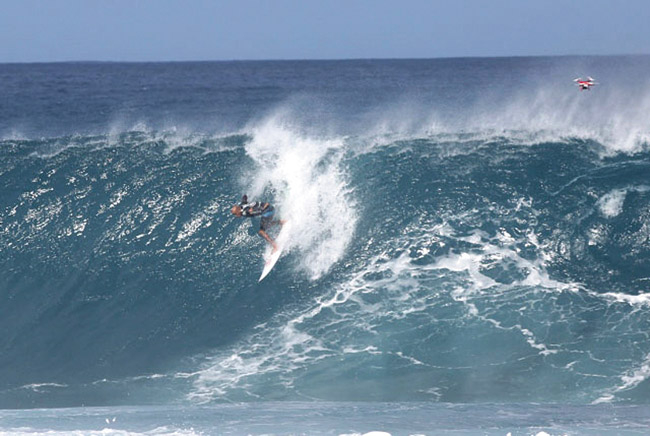Airing Concerns About Hawaii’s Drones
In this high-tech gadget world we live in, new toys are surfacing at a rate that society may not be able to grasp fully or completely understand.
Such is the case with unmanned aircraft, commonly known as drones.
mw-mizutani-022614-volcomkelly
It seems everywhere you turn these days someone has attached their video camera to a remote-controlled model airplane or helicopter and capturing aerial footage few have ever seen before.
We saw one hovering over the starting line at the Great Aloha Run, and they’ve become quite common on Oahu’s North Shore.
“The GoPro drone helicopters were zooming in and out of the lineup, and even flying right near the barrel with Kelly Slater,” says veteran photographer Terry Lilley of Kauai. “They had two drones hovering in front of and behind Kelly Slater on each wave. It was crazy!”
Phenomenal GoPro footage captured high above Pipeline from a drone has gone viral. Other video clips of traffic congestion near Laniakea Beach and destructive erosion near Sunset Beach, again captured from an unmanned aircraft, have provided landowners and state officials with views normally reserved for helicopter rides.
The phenomenon even has expanded its reach to the Neighbor Islands.
“We just got our first drone helicopter to use to monitor the reefs and wetlands on Kauai!” exclaims an excited Lilley.
No, this isn’t your father’s model airplane hobby anymore – this is high-tech, high-quality video being shot from an aircraft without a human pilot. Many of them come equipped with GPS and some can cost more than $1,000.
The merge in technology is creating a stir across the nation, and we’ve only scratched the surface of the issue here in Hawaii. While it’s still extremely controversial, Lilley and others believe drones can be valuable tools for research.
“We now can do daily flyovers and research with the drone studying reefs, whales, rivers, beaches, sea-level rise and wetlands,” says Lilley. “We’ll use it to GPS from above our scuba dives, and track the mud flowing out of the river and creeks onto the reefs. This is a wonderful new tool, and if you are thinking about digging in the wetland or discharging mud out to sea to kill the reefs, we’ll be watching from above!”
But some believe “watching from above” crosses the line when it comes to privacy rights, and in worst-case scenarios, can be abused for personal gain. Others worry that lack of enforcement of existing federal laws will lead to even more traffic in the sky.
“We have drone traffic jams on Oahu, and without proper training, it’s easy to lose control of these helicopters,” says Lilley. “At pro surf contests, some of them are flying near real helicopters, surfers on giant waves and thousands of people on the beaches!”
Besides photographers and land surveyors, Realtors and even scientists observing humpback whales are using the new technology. The hot trend is booming and local sales of these unmanned aircraft are skyrocketing. Drones are easy to buy online from websites like https://www.drdrone.ca/, meaning that anyone who wants to own a drone can do so with little legal oversight.
The Federal Aviation Administration is on alert and is reminding “fliers” that you can shoot video for personal use, but if you sell the clip or use it to promote a business, you’re breaking federal laws. Few know these laws even exist.
State lawmakers also are currently examining the future of drones in Hawaii. Seven bills are before legislators this session, including one that would make it illegal for police to monitor residents using drones without due process.
Are state laws necessary? Certainly there are more pressing matters to address at the state Capitol, but considering the boom in popularity of drones, the lack of understanding of this ever-evolving technology and the importance of protecting people’s privacy, something needs to be done sooner rather than later.
Someone needs to be watching over this trend or it quickly could spiral out of control.
rkmizutani@gmail.com






